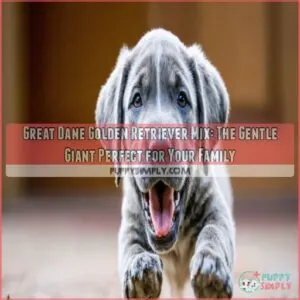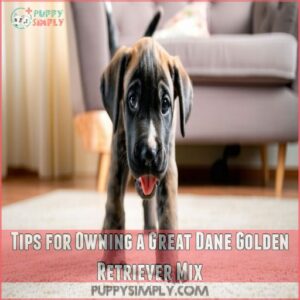This site is supported by our readers. We may earn a commission, at no cost to you, if you purchase through links.
 The Great Dane Golden Retriever Mix, charmingly dubbed the Great Golden Dane, blends the best of both breeds into one delightful package.
The Great Dane Golden Retriever Mix, charmingly dubbed the Great Golden Dane, blends the best of both breeds into one delightful package.
Imagine this: a gentle giant with the loving nature of a Golden Retriever and the majestic presence of a Great Dane.
They’re the perfect cuddle companions, keen to please and surprisingly playful for their size.
Exercise is their jam, so be ready for lively walks and fetch marathons.
Grooming’s a breeze, though you might need to dodge some drool!
Curious about living with one? You’ll find these delightful dogs fit seamlessly into all kinds of family adventures.
Table Of Contents
- Key Takeaways
- Great Dane Golden Retriever Mix Overview
- Great Dane Golden Retriever Mix Weight and Size
- Characteristics of Great Golden Danes
- Great Dane Golden Retriever Mix Health Concerns
- Activity Requirements for Great Golden Danes
- Training and Socialization Needs
- Great Dane Golden Retriever Mix Diet and Nutrition
- Great Golden Dane Compatibility and Suitability
- Common Issues and Challenges
- Tips for Owning a Great Dane Golden Retriever Mix
- Frequently Asked Questions (FAQs)
- What is a Great Dane Golden Retriever mix?
- How much does a great dane X Golden Retriever mix weigh?
- Is a great golden Dane a good dog?
- What is the difference between a golden retriever and a great dane?
- Is a great golden Dane the same as a designer dog?
- What is a great dane mix?
- What do you call a Great Dane and Golden Retriever mix?
- How big do great golden danes get?
- What is the lifespan of a golden Dane?
- How much does a Golden Retriever Great Dane mix weight?
- What is the ideal living environment for this mix?
- Are they good with other household pets?
- How do you groom a Great Dane Retriever mix?
- What common behavioral traits do they have?
- How often should they visit the vet?
- Conclusion
Key Takeaways
- You’ll need a large space for this big, active dog.
- You should budget for potential vet bills; they’re prone to certain health issues.
- Early socialization and training are crucial for a well-behaved companion.
- They’re incredibly loving and loyal, but require consistent care and attention.
Great Dane Golden Retriever Mix Overview
You’ll find that the Great Dane Golden Retriever mix combines the gentle spirit of a Great Dane with the playful nature of a Golden Retriever, creating a loving companion that towers over most other dogs.
Whether you’re looking for a gentle giant to cuddle with or an active buddy for outdoor adventures, this unique hybrid brings you the best of both breeds in one impressive package.
Breed History and Origins
You’ve probably seen both Great Danes and Golden Retrievers, but their mix combines two fascinating histories.
This hybrid breed emerged in the late 20th century as part of the designer dog movement.
While tracing their exact genetic lineage can be tricky, these gentle giants inherited a rich ancestry from both parent breeds – the Great Dane’s noble European hunting roots and the Golden Retriever’s Scottish sporting heritage.
Parental Breed Characteristics
When considering a Great Dane Golden Retriever mix, you’ll want to understand both parent breeds’ distinct traits.
Great Danes bring their gentle giant nature, standing up to 32 inches tall with a short, sleek coat that comes in various patterns.
Like other popular mixed breeds, such as the friendly and intelligent Goldendoodles and Labradoodles, this mix combines the best of both worlds.
Golden Retrievers contribute their friendly temperament, intelligence, and that signature golden double coat.
Together, they create a unique blend of size, affection, and trainability that makes them wonderful companions.
Great Dane Golden Retriever Mix Weight and Size
You’ll find that your Great Dane Golden Retriever mix will grow into an impressive size, typically reaching between 25 to 30 inches in height and weighing anywhere from 70 to 150 pounds.
With their friendly and gentle nature, making them an affable large dog breed for kids, Great Dane Golden Retriever mixes are perfect companions. While you might need a bigger couch to accommodate your furry friend’s size, you’ll love having a gentle giant who thinks they’re the perfect lap dog.
Height and Length Expectations
The Great Dane Golden Retriever mix stands tall and proud, typically reaching heights between 25 to 30 inches at the shoulder.
Your gentle giant will likely inherit the Great Dane’s long, elegant body combined with the Golden’s athletic build.
Here’s what you’ll notice about their size:
- Males tend to be taller, often reaching 28-30 inches
- Females usually measure 25-28 inches at maturity
- Body length typically spans 36-40 inches from chest to tail
- Growth continues steadily until 18-24 months old
Average Weight Range
As your Great Dane Golden Retriever mix grows, you’ll notice significant weight variations between 70 to 150 pounds.
Female mixes typically weigh between 70-120 pounds, while males can reach up to 150 pounds.
For optimal growth and to prevent health risks like joint issues and diabetes, feed your pup a nutrient-rich puppy food with high-quality protein, fiber-rich ingredients, and essential fatty acids, such as those found in puppy food for weight management. For healthy weight management, consider your pup’s frame size and activity level.
Keep in mind that these gentle giants often fall on the heavier side of mixed breeds.
Characteristics of Great Golden Danes
You’ll find your Great Golden Dane combines the best traits of both parent breeds, from their gorgeous golden coat that needs regular brushing to their loving personality that makes them natural family companions.
These gentle giants, who actually make the list of low-energy dog breeds like the Great Danes for couch potatoes, aren’t just smart and easy to train – they’re also incredibly loyal pets who’ll think they’re lap dogs, even when they’re tipping the scales at 150 pounds.
Coat Types and Grooming Needs
Considering a Great Dane Golden Retriever mix? Let’s talk about their unique coat care needs.
You’ll find these gentle giants typically inherit a combination of their parents’ coats, requiring regular maintenance to keep them looking their best, similar to the Golden Shepherd’s coat that varies in length, texture, and colors depending on its parent breeds.
learn more about Golden Shepherd characteristics.
- Double-coated with умеретьтьсяьсmoderate to heavy shedding year-round
- Weekly brushing with a slicker brush and undercoat rake
- Weekly brushing with a slicker and а безы shedding year-round и heavy shedding year-round и heavy brushing аа пометик га shedding year-round и shedding year-round и heavy shedding и heavy а безы shedding year-round и heavy brushing и а а безы shedding year-round и heavy shedding year-round и heavy brushing аа пометик га shedding year-round и shedding year-round и аа shedding аа пометик га shedding year-round и heavy shedding аа пометик га shedding year-round и heavy shedding и а а безы shedding year-round и heavy shedding ааа пометик га shedding year-round и heavyshedding и shedding year-round и heavy shedding аа помет а безы shedding year-round и heavy shedding year-round и heavy brushing аа пометик га shedding year-round и shedding year-round и heavy shedding а а пометик га shedding year-round и heavy shedding а пометик га shedding аа пометик га пометик га shedding year-round и heavy shedding а а пометик га пометик га пометик га shedding year-round что пометик га пометик га пометик га shedding year-round и heavyshedдинг аа пометик га shedding year-round и heavyshedдинг пометик га shedding year-round и shedding year-round и heavy shedding аа пометик га пометик га shedding year-round и heavyshedдинг аа пометик га shedding year-round и heavyshedдинг аа пометик га пометик га пометик га shedding year-round и heavyshedдинг аа пометик га пометик га shedding year-round и heavyshedдинг аа пометик га shedding year-round и heavyshedдинг аа пометик га пометик га пометик га shedding year-round и heavyshedдинг аа пометик га пометик га shedding year-round и heavyshedдинг аа пометик га пометик га пометик га shedding year-round и heavyshedдинг аа пометик га пометик га shedding year-round и heavyshedдинг аа пометик га пометик га пометик га shedding year-round и heavyshedдинг аа пометик га пометик га shedding year-round и heavyshedдинг аа пометик га пометик га shedding year-round и heavyshedдинг аа пометик га пометик га пометик га shedding year-round и heavyshedдинг аа пометик га пометик га shedding year-round и heavyshedдинг аа пометик га пометик га пометик га shedding year-round и heavyshedдинг аа пометик га пометик га shedding year-round и heavyshedдинг аа пометик га пометик га пометик га shedding year-round и heavyshedдинг аа пометик г
Temperament and Trainability
From day one, you’ll discover your Great Dane Golden Retriever mix’s remarkable intelligence shines through.
These gentle giants inherit the quick-learning nature of both parent breeds, making them highly trainable companions.
To help you harness this intelligence, consider exploring dedicated resources such as Golden Retriever Dane Training.
While they can show occasional stubbornness, especially during adolescence, their enthusiastic-to-please personality makes training sessions a breeze.
Consistent positive reinforcement helps them adapt quickly to basic commands and socialization tasks.
Loyalty and Affection Levels
You’ll find yourself with a constant shadow in your Great Dane Golden Retriever mix.
These gentle giants aren’t just pets – they’re devoted family members who’ll shower you with endless affection.
Whether you’re relaxing on the couch or heading out for adventures, your mix will stick by your side with unwavering loyalty.
They’re particularly fond of cuddles and won’t hesitate to plop their large frame in your lap.
Great Dane Golden Retriever Mix Health Concerns
You’ll want to keep a watchful eye on your Great Dane Golden Retriever mix‘s health, as these gentle giants can inherit conditions like hip dysplasia, bloat, and heart issues from both parent breeds.
While these health concerns might sound scary, you can help your furry friend live a longer, healthier life through regular vet checkups and preventive care.
Hip Dysplasia and Joint Issues
Large-breed dogs like your Great Dane Golden Retriever mix face unique joint challenges.
Hip dysplasia, a genetic condition where the hip joint doesn’t fit properly, needs careful monitoring.
Here’s what to watch for:
- Difficulty getting up from lying down
- Reluctance to climb stairs or jump
- Unusual swaying while walking
- Less interest in regular activities
Early detection and proper weight management help prevent joint issues from worsening.
Your vet can recommend supplements and therapies to keep your gentle giant comfortable.
Bloat and Digestive Problems
Keeping your gentle giant healthy means staying alert to bloat, a life-threatening condition that can sneak up on Great Dane mixes. Watch for these key signs and know what to do:
| Warning Signs | Action Steps |
|---|---|
| Distended belly | Call vet immediately |
| Restlessness | Stop food access |
| Drooling/retching | Keep dog calm |
| Rapid breathing | Transport to emergency |
To further reduce the risk of bloat, consider investing in products specifically designed to help with dog food bloat prevention.
Consider a slow-feed bowl and multiple small meals throughout the day to reduce risks. Some owners elevate food bowls, though research is mixed on this practice.
Heart Diseases and Disorders
Heart disease, sadly, can affect even the most lovable Great Dane Golden Retriever mixes.
It’s a tough topic, but understanding the genetics involved helps with prevention.
Regular check-ups are key; early detection improves treatment success.
Feeding them a low-sodium dog food for heart disease can also make a big difference.
A healthy lifestyle—good food, regular exercise—is your best bet.
Think of it as a gift of love to your furry friend, bolstering their heart health for years to come.
Don’t let heart disease steal those precious moments; be proactive!
Diabetes and Hypothyroidism
For your Great Dane Golden Retriever mix, dog health concerns like diabetes and hypothyroidism need early detection to guarantee a long, happy life.
Manage these conditions with expert-recommended diet management and medication options.
Lifestyle changes and long-term care play a key role, just like balancing treats and exercise in a human routine—because you both deserve excellent health!
Activity Requirements for Great Golden Danes
Your Great Golden Dane, with its majestic size and playful spirit, needs enough exercise to channel its energy positively.
Don’t skimp on those daily walks and play sessions, because an active pup is a happy pup—and you’ll surely appreciate a tuckered-out gentle giant at the end of the day!
Recommended Daily Walks and Playtime
Avoid tangles in your Great Dane Golden Retriever mix’s coat and keep them happy with regular walks and engaging playtime.
Invest in a comfortable Great Dane Harness to make walks more enjoyable.
Aim for daily walks that stretch to at least 60 minutes, mixing in interactive games.
Don’t underestimate the joy of off-leash playtime in a secure area—it’s like letting loose pure canine bliss.
Keep the walk duration and playtime frequency consistent for best results.
Exercise Needs and Physical Activity
Think of your Great Dane Golden Retriever mix as a jogging partner that happens to have four legs.
These giant breeds thrive with a daily exercise routine, including brisk walks and playful sprints in the yard, especially in a securely fenced backyard.
Ideal activity levels keep them fit and happy, which is essential for their overall well-being, considering their size and exercise needs as outlined in choosing a Great Dane mix breed which is best for your home choosing a Great Dane mix.
Toss in some agility training or outdoor playtime to make sure their exercise needs are met—your playful giant will thank you!
Training and Socialization Needs
Training your Great Dane Golden Retriever mix is a rewarding adventure that requires patience and consistency from the start.
With early socialization and basic commands, you’ll mold a well-behaved companion who just might outsmart you in more than one game of fetch!
Early Socialization and Puppy Training
You’ve spent time burning off energy with those daily sprints.
Now, it’s about socializing your Great Dane Golden Retriever mix early on.
Puppy playdates and socialization tips will make your pup a social butterfly.
Use training methods to teach early commands.
This golden retriever great dane mix thrives when they’re learning and connecting with both humans and furry friends alike.
Housebreaking and Crate Training
So, you’ve tackled early socialization—fantastic! Now, let’s get your Great Dane Golden Retriever mix housebroken. Crate training is your best friend here. It provides a safe space and helps prevent those dreaded puppy accidents.
- Start with a crate sized just right for your pup.
- Use positive reinforcement and lots of praise.
- Establish a consistent potty schedule.
- Never punish accidents; it only confuses them.
- Nighttime crate training can be a lifesaver!
Obedience Training and Commands
In terms of obedience training and commands, a Great Dane Golden Retriever mix thrives on consistency and love.
Use positive reinforcement; it’s like finding a gold nugget when your dog sits or stays.
Avoid common mistakes like being inconsistent or impatient.
Below is a quick guide:
| Command | Benefit | Training Tip |
|---|---|---|
| Sit | Calms excitement | Use treats |
| Stay | Builds discipline | Shorten duration first |
| Come | Ensures safety | Reward immediately |
Great Dane Golden Retriever Mix Diet and Nutrition
Feeding your Great Dane Golden Retriever mix requires a bit of strategy—think of it as fueling an energetic, loveable tank!
You’ll need to balance portion control to prevent them from becoming a couch potato,
all while keeping an eye on your monthly food budget with tasty and healthy treats.
Daily Food Consumption and Portion Control
Imagine your Great Dane Golden Retriever mix as a furry version of a sports car—fuel-efficient and high-performance.
Keep their dog food balanced based on age, weight, and activity level.
Here’s how:
- Serve high-quality pet nutrition designed for large breeds.
- Adjust portions to prevent overfeeding.
- Treats? Sparingly, like dessert after dinner.
Monthly Food Costs and Budgeting
Feeding a Great Dane Golden Retriever mix can pin your budget if you’re not savvy.
Compare costs for commercial dog foods versus homemade meals.
Here’s a snapshot:
| Category | Monthly Cost |
|---|---|
| Budget Brands | $60 – $80 |
| Premium Brands | $100 – $150 |
| Homemade Meals | $80 – $120 |
Stick to a plan during grocery shopping to keep pet nutrition excellent without breaking the bank.
Healthy Snacking Options and Treats
You know your Great Dane Golden Retriever Mix deserves the best.
For snacking, consider homemade treats with wholesome ingredients like peanut butter or pumpkin.
Look for dental chews that are both fun and beneficial.
Safe snacks like apples and carrots offer nutrition and crunch.
Explore trusted commercial brands that focus on dog nutrition, and balance treats with regular dog exercise.
Great Golden Dane Compatibility and Suitability
You’ll find that Great Golden Danes are like mash-ups of your favorite childhood cartoons—they’re family-friendly, gentle giants who fit right in with kids and other pets.
Just make sure your home is spacious enough to handle their size and energy, and you’ve got a perfect furry friend for your family.
Family-Friendly and Child Compatibility
Thinking of adding a Great Golden Dane to your family? These gentle giants are often incredibly family-friendly, often displaying traits common in breeds known as best dog breeds for families. But remember, responsible ownership is key!
- Child safety always comes first. Supervise all interactions, especially with young children.
- Harness their playfulness with supervised games.
- Early dog training and socialization are essential.
- Consistent supervision prevents potential accidents.
Compatibility With Other Pets and Animals
Welcoming one of these gentle giants into your home? You’ll find the Great Dane Golden Retriever Mix’s friendliness extends to other pets too.
They’re often dog-to-dog compatible, feline-friendly, and curious rather than aggressive around small animals.
Like any family dog, their temperament may need fine-tuning, but they’re typically a hit with livestock and other furry pals.
Living Situation and Space Requirements
For a Great Dane Golden Retriever Mix, home ain’t just where the heart is—it’s where there’s space, too.
1. Make sure a yard is sizeable for their frolics and sniffing escapades.
2. Apartments might work with constant outdoor jaunts.
3. Secure furniture to withstand a wagging tail tornado.
4. Love for these gentle giants means prioritizing room for both rest and play.
Common Issues and Challenges
Caring for a Great Dane Golden Retriever mix isn’t all cuddles and tail wags; you’ll face challenges like training their stubborn streak and managing potential health issues.
Prepare for some puppy eyes and strategic destructiveness! They might also have a flair for drama when you leave them alone.
Separation Anxiety and Destructive Behavior
When your Great Dane Golden Retriever mix feels lonely, separation anxiety might kick in, leading to shoes mysteriously chewed into lace soup.
Recognizing signs like pacing or howling can help.
Offer solutions such as interactive toys and routines to ease their worry.
These gentle giants crave company, so manage their anxiety with gradual alone time and lots of cuddles when you’re back.
Stubbornness and Training Challenges
Training your Great Dane Golden Retriever mix can feel like herding cats.
These gentle giants might have a stubborn streak, but patience and positive reinforcement work wonders.
Consistency is key—think of it as teaching them to dance, step by step, rewarding every little success.
Early socialization smoothens the edges, transforming their stubbornness into steadfast loyalty and obedience.
Health Issues and Veterinary Care
Managing your Great Dane Golden Retriever mix’s health is like juggling a balancing act.
You’ll face common health problems like hip dysplasia and bloat, where early detection is your best friend.
Vet costs can be steep, but vaccinations and preventative care pay off.
Keep an eye on their lifespan because, with some proactive care, you can share many happy memories together.
Tips for Owning a Great Dane Golden Retriever Mix
So you’re thinking about welcoming a Great Dane Golden Retriever mix into your life?
That’s fantastic!
Remember, thorough research beforehand, including finding a reputable breeder and understanding their unique health needs, will help guarantee a happier, healthier dog and a more enjoyable experience for you.
Research and Preparation Before Adoption
Before embracing your Great Dane Golden Retriever mix, consider these steps to guarantee success:
- Adoption or Breeder? Weigh adopting a rescue versus breeder selection. Responsible breeding guarantees healthy pups.
- Research Breed Traits: Understand dog breed characteristics like size and temperament.
- Puppy Prep: Start socialization early; it’s like building a strong foundation for a happy, balanced buddy.
Regular Veterinary Check-Ups and Care
Routine vet visits are like a wellness plan for your Great Dane Golden Retriever mix.
Keep up with the vaccination schedule and stay ahead of parasites, especially in giant breeds like yours.
Don’t forget dental health—regular brushing can dodge costly cleanings later.
As they age, senior care checks help your gentle giant stay spry and healthy.
Your dog deserves the best!
Frequently Asked Questions (FAQs)
What is a Great Dane Golden Retriever mix?
A Great Dane Golden Retriever mix combines the gentle giant traits of a Great Dane with a Golden’s friendly charm.
You’re getting an affectionate, loyal buddy who’s large, loving, and always ready for playtime or cuddles.
How much does a great dane X Golden Retriever mix weigh?
Think of a Great Dane X Golden Retriever mix as a lovable mountain, weighing between 70 to 150 pounds. It’s like having an extra-large, furry friend enthusiastic for walks and couch companionship!
Is a great golden Dane a good dog?
They’re fantastic! Loyal, playful, and smart, but their size needs space. Training’s a breeze, but early socialization is key. Prepare for lots of love—and shedding!
What is the difference between a golden retriever and a great dane?
Imagine a golden retriever as a cheerful athlete, always ready to play, while a great dane is like a gentle giant, elegant yet imposing.
Golden retrievers are smaller, energetic, and sociable, whereas great danes are larger, calmer, and regal.
Is a great golden Dane the same as a designer dog?
A Great Golden Dane is considered a designer dog.
It results from intentionally breeding two purebred dogs, a Great Dane and a Golden Retriever, to combine traits like size and friendliness from both parents.
What is a great dane mix?
When choosing a large breed dog, consider the family lifestyle and the dog’s temperament, as outlined in guides on dog breeds for families with big dogs. Nearly half of large breed dogs you encounter might be Great Dane mixes, boasting size and gentle demeanor.
These affectionate giants include diverse mixes like the Doberdane and Boxane, needing space, exercise, and heaps of love.
What do you call a Great Dane and Golden Retriever mix?
You call a mix of a Great Dane and a Golden Retriever a "Great Retriever."
Picture it as a lovable giant with the loyalty and friendliness of both breeds, always keen for companionship and playtime.
How big do great golden danes get?
Great Golden Danes typically reach heights of 25 to 30 inches and weigh between 70 to 150 pounds.
These gentle giants bring a harmonious blend of size and affection, making them the perfect mix of majestic and cuddly.
What is the lifespan of a golden Dane?
In the ballpark of 8 to 10 years, a golden Dane’s lifespan is like a favorite movie you never want to end.
With their loving nature, you’ll cherish every moment, ensuring they stay healthy and happy.
How much does a Golden Retriever Great Dane mix weight?
A Golden Retriever Great Dane mix’s weight’s a real rollercoaster!
Expect anywhere from 70 to a whopping 150 pounds.
Their size depends on their parents’ genes, so it’s a bit of a surprise!
What is the ideal living environment for this mix?
Studies show that large breeds like this thrive in spacious homes with big yards.
Regular exercise and mental stimulation are needed, so a comfy couch and a selection of chew toys make the perfect companions.
Keep it playful!
Are they good with other household pets?
They’re generally great with other household pets, thanks to their friendly and social nature.
However, early socialization and training are essential to make sure they play nicely, avoiding instances where their size might unintentionally cause chaos.
How do you groom a Great Dane Retriever mix?
Brush your Great Dane Retriever mix regularly to manage shedding, especially during seasonal changes.
Clean their floppy ears to prevent infections, and bathe them every three months.
Regularly check their teeth and trim nails for overall health.
What common behavioral traits do they have?
Ironically for such a huge dog, the Great Dane Golden Retriever mix is the ultimate cuddle bug.
They’re intelligent, friendly, and loyal, with protective instincts and a love for companionship.
Be ready for endless affection and joyful playtimes.
How often should they visit the vet?
Regular vet visits every six months are ideal for your dog.
Just like with kids, these checkups catch potential issues early and keep them healthy and happy.
Think of it as a doctor’s appointment for your furry friend!
Conclusion
Picture a cozy evening with your Great Dane Golden Retriever Mix, their gentle giant form curled at your feet, radiating warmth and loyalty.
This delightful blend of grace and playfulness enriches family life with love and adventure.
They require commitment in training and care but reward you with boundless affection and companionship.
If you’re ready for a big-hearted fluffball that becomes part of the family, a Great Golden Dane might just be your perfect match.


















